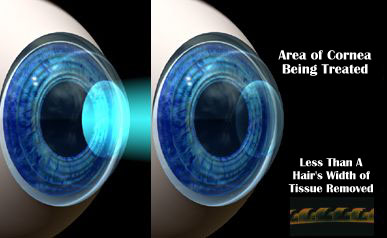PRK (PHOTOREFRACTIVE KERATECTOMY SURGERY)
PRK PROCEDURE

The PRK procedure is similar to that of LASIK in the way the laser is applied to the eye.
The main difference is that there is no flap created by the surgeon using a microkeratome. Instead, the laser is used to produce your optical correction by reshaping the outermost surface of the cornea, rather than the tissue beneath a flap, as in LASIK.
This requires the removal of a thin layer of the corneal epithelium, which may produce varying degrees of temporary discomfort for up to a few days after your treatment. In general PRK provides a slower visual recovery than LASIK.
The surgeon will often prescribe additional medications and a thin, soft bandage contact lens to make you more comfortable for a few days after your treatment.
While PRK is only occasionally recommended, it has a distinct place for some patients.
PRK is recommended for those patients:
- Whose corneas are too thin to have LASIK safely
- Whose corneas display evidence of scarring from infection or trauma
- Who are active or reserve military personnel
ADVANCED SURFACE ABALATION
Involves surface laser treatment with removal of corneal epithelium and direct treatment onto the corneal stroma without creating a flap unlike lasik. After laser treatment a chemical is applied to the corneal stroma know as mitomycin c for 15 seconds to 2min depending on the condition of the cornea for fibroblast or haze modulation . After this a bandage contact lens is put on the eye for about three to four days till the new corneal epithelium grows back.
ASA is a better choice for those who :
- Want to reduce or eliminate their dependence on glasses or contacts
- Are over 18 years of age
- Have had a stable eye prescription for at least one year
- Have no health issues affecting their eyes
- Have wide pupils
- Have corneas too thin for LASIK
- Want to avoid LASIK flap complications
- Who want to minimize dry eye problems after surgery
- Who cannot have LASIK because of eye pressure problems (glaucoma)
- Who cannot have LASIK because of corneal dystrophy problems
- Who do not want LASIK because it requires a microkeratome
The amount of treatment done is about minus six and on the plus side upto four numbers. For treatment of higher numbers the treatment response show corneal haze and unstable removal of numbers showing regresssion. Thus advance surface abalation is limited for special situations where lasik is not preferred.
Advanced surface abalation recovery is slow with vision slowly stabilizing in a weeks time unlike the fast recovery with lasik.
The option is discussed with the patient with the pros and cons and the limitations of the treatment. Post procedure care eye drops to be continued for about two months and lubricating drops till six months.
The quality of vision at the end of three months compared to the lasik group is the same. the advance surface abalation is a good option for thin corneas and boderline cases where lasik is dicey.
Advance surface abalation the surface treatment involves removal of epithelium which can be removed by manual scrapping or alcohol assisited removal i.e.LASEK or transepithelial laser removal known as PRK. Thus advanced surface abalation has different names like LASEK, PRK, epilasik, ASA.
For more details discuss the option with your Kenia eye surgeon about the suitability of the procedure for the best possible result.